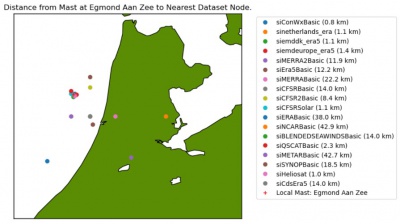EMD-API - Climate Data Access: Difference between revisions
mNo edit summary |
mNo edit summary |
||
| Line 9: | Line 9: | ||
== API Access == | == API Access == | ||
The API is currently (August 2020) in beta-release. | The API is currently (August 2020) in beta-release. | ||
To see more documentation and to access the data-services, please visit the API through the following URL: | To see more documentation and to access the data-services, please visit the API through the following URL: | ||
| Line 41: | Line 40: | ||
jupyter notebook | jupyter notebook | ||
</pre> | </pre> | ||
== Client Software Other Languages and Tools == | == Client Software Other Languages and Tools == | ||
Revision as of 08:51, 26 August 2020
Origin and Purpose

EMDAPI is a software library by EMD delivering a unified interface to a wide range of climate data. EMDAPI helps consultants, analysts and scientists working with high-resolution climate data in achieving their goals in an efficient way, it has the following key-features:
- 40+ climate datasets: EMDAPI provides access more than 40 of the best climate datasets and allows access to more than 1Pb of data.
- Unified interface: The unified interface which allows for integration to internal processes and tools - and also very efficient uncertainty analysis with gigabytes of data easily accessed.
- Trusted datasets: The EMDAPI builds upon the trusted data-bases and data-sources that have been used through the online-data services in windPRO for more than a decade.
- Built on open standards: he EMDAPI is a REST based service that implements the OpenAPI standard].
- Available from any development tool: Access to the climate databases is available from your preferred development platform - C#, R, python, html, java, php, scala and swift. Just use the OpenAPI tools to generate the client software for your preferred platform.
API Access
The API is currently (August 2020) in beta-release. To see more documentation and to access the data-services, please visit the API through the following URL:
Python - Installation and Test

The simplest way to use the EMDAPI with python is to install the client software in a virtual environment. If you are using CONDA or MINICONDA, we recommend that you create a new virtual environment and use a recent 3.x version of python. When the virtual environment is created, then activate the environment.
conda create -n emdapi python=3.8 conda activate emdapi
Install the required packages needed in order to do data-science and use the examples provided within the jupyter notebooks:
conda install pandas numpy matplotlib basemap basemap-data-hires jupyter
Download the zipped-file holding the OpenAPI python client. Unpack the file and install it within your virtual environment:
python setup.py install
Ensure that the python-kernel is available from the jupyter-notebook:
python -m ipykernel install --user --name=emdapi
Give the installation a test-drive using the jupyter notebooks provided
jupyter notebook
Client Software Other Languages and Tools
A list of client software generated from the swagger editor is found below.
If you want to generate the client libries yourself (or for other tools than above), one possible process is to: